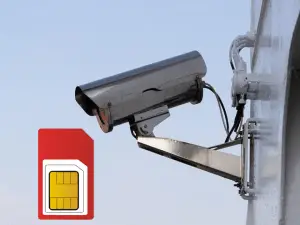
Smart security cameras or IP cameras are fantastic pieces of kit because of the peace of mind that they provide.
After all, it is pretty awesome to be able to connect to a security camera even when you are not at home.
Or those people who live in RVs and trailers and move around a lot?
How can these people monitor valuable possessions and properties?
By using a cellular security camera.
For those of you in a rush, take a look at my top 4 models below.
FAQs About Cellular Security Cameras
Let me start off with some questions. After all, you probably have several going round in your head right now and some of those might be in the nine questions I have answered below.
[1] What are cellular security cameras also known as?
These cameras can also be called 4g security cameras or LTE security cameras.
[2] How do cellular security cameras work?
Cellular security cameras work by connecting to a cellular phone network using a SIM card
And it is this card that connects the camera to the Internet via the cellular networks of huge companies like AT&T, Verizon and Sprint.
Within the camera is a slot that you place a SIM card in. This card then connects to the phone masts and network, just like your phone.
Your cellular camera can then transmit data such as audio, photos or video to a user’s phone and cloud storage facilities.
The SIM card will not allow your camera to connect to a standard Wi-Fi network in your home or business because it does not contain a Wi-Fi adapter.
In this way, it is not like your smartphone because your phone contains both a SIM card and a Wi-Fi adapter.

[3] What are some of the disadvantages of 4G security cameras?
But it is not all good news.
Firstly as someone who is desperate to buy a 4G security camera there is not a huge range of choices out there.
The marketplace is still pretty small. I review 12 of these cameras and to tell you the truth, it was a struggle to find that number!
And there are a great number of these cameras that I wouldn’t touch with a barge pole and my reviews say it as it is.
And secondly, most of the cellular security cameras seem to only work with a couple of providers- normally AT&T and Verizon.
Which is a big restriction when compared to smart security cameras that will connect to any Wi-Fi network regardless of who the supplier is.
[4] How Much Do The SIM card plans cost?
As an owner of a cellular security camera, you will need to get a SIM card with a data plan.
The exact cost of these data plans vary depending on the type of data that your camera uses and how active it is.
The Arlo Go when it senses motion, records a video clip which can be as short as 10 seconds.
The cheapest data plan for the Arlo Go is for 15 minutes of video, which costs $3.99 per month.
The most expensive plan with 225 minutes of video costs just over $26 per month.
In contrast, although the Vosker 200 can record video clips, it will also just send photos.
A plan that allows the camera to send 500 photos to you per month costs $10 per month whereas if you want to receive an unlimited number of photos that will cost $20 per month.
[5] How much data does a cellular security camera use?
This all depends on how long the camera is operational for and on the settings within your camera. And remember, any calculation can only be a rough estimate.
If your camera is streaming very high quality videos to your phone (about 1.5 Mbps) then it will use about 1 GB of data for every hour of footage.
However, if you set your camera to stream lower quality images (say 200 kbps) 1 GB of data will last about 10 hours.
[6] Does AT&T have cellular security cameras?
No. At this time, AT&T do not manufacture their own cellular security cameras. Instead through their cellular phone network they provide SIM cards and data plans that will work in 4G security cameras made by other companies.
AT&T Data SIM cards are probably the most commonly used SIM cards in cellular security cameras in the US at the moment. This is probably because AT&T’s coverage is just so good across all parts of America.
Some of the most popular LTE cameras that are compatible with AT&T SIM plans include the Arlo Go and the Reolink Go.
[7] Does AT&T have other security cameras?
AT&T doesn’t make its own cameras but it does have a home security service that uses security cameras and other monitoring devices such as window sensors to help with your home security.
The service is called Digital life and it costs from about $550 per year. This is a subscription and so it will need to be paid every year.
A team of installers come to your house and set up all of the security cameras and other monitoring devices that you need.
You then have an app on your phone that connects to all of your devices and helps you to monitor your home’s security wherever you are.
[8] Does Verizon have security cameras?
Verizon does not make any security cameras themselves.
They sell a range of security cameras made by some of the best names in home security, such as Canary, Arlo and Nest via their website.
But perhaps their strongest connection to security cameras is via their Data SIM cards. These SIM cards are used in a special type of security camera, called cellular security cameras. These cameras have an internal slot for a SIM card which connects the cameras to the cellular network (and the Internet.)
[9] Do wireless security cameras need the Internet?
Wireless security cameras do not need the Internet to record footage and they don’t need the Internet to store the footage if the camera has a built in SIM card.
But they do need the Internet to be able to do the really clever stuff such as to send you notifications after they have detected motion, to send footage to the cloud to be stored and if you want to connect to the security camera live.
Key Features of a LTE Security Camera
Motion Sensing vs CVR
All of the cameras in my comparison are motion sensing cameras.
This means that the camera spends most of its life on “standby”, whereby the camera is effectively doing nothing apart from waiting.
Then once the camera detects motion it springs to life, taking a series (or burst) of photos or a short video clip before returning to idle to wait for the next motion.
The reason that I am explaining this is because some WiFi security cameras can record continuously.
These cameras are never on standby and record footage regardless of whether there is motion or not.
This feature is also called CVR- continuous video recording but cellular security cameras cannot do this at the moment.
Storage
And the reason that most 4G security cameras cannot record 24/7 is because of the type of storage that most of them are dependent on.
Most of the cameras in my selection use micro SD cards or TF cards for storage and most of these have a capacity of about 64 GB, which is a lot of space but not when your camera is recording non stop.
Power
Another powerful reason that LTE security cameras are not capable of CVR is that most of them are powered by batteries which would drain very quickly if the camera was recording all the time.
It makes perfect sense for a camera which is designed to be used in remote places to be powered by batteries because remote locations, as well as not having WiFi access, tend to have a limited number of electrical sockets, if any at all.
The models in my comparison are powered in one of four ways:
*AA batteries, which you would need to purchase separately.
*Built in rechargeable batteries
*Power cable
*Solar panel
Of these, the majority are powered by AA batteries, which would need to be purchased separately.
I think that powering a camera used in a remote location with AA batteries makes more sense than having a built in rechargeable battery because when AA batteries run out of power, you can just replace them with brand new ones or take them back home with you to be recharged.
If your camera has a built in battery and it is located in an isolated spot without any electricity, the whole camera may need to be removed in order for the battery to be recharged.
To overcome this issue, one of the cellular security cameras in my comparison has a built in solar panel.
But there are other models that can be powered by solar panels- you will just need to buy the panels separately.
Motion Detection
The ability to detect any movement and then alert a camera owner quickly is one of the most highly sought after qualities in any camera.
And all the cameras in my comparison use passive infrared (PIR) to do this.
The infrared sensor within a security camera contains two parts- a diode which senses infrared energy and an LED which transmits it.
As far as motion detection goes, we are only interested in the diode.
The heat from the body of an animal or human is transmitted as infrared energy.
And when this source of infrared moves, a diode on the infrared sensor detects it and creates a motion alert.
Because motion detection is such an important feature, I need to explain it all in a bit more depth.
The location that any security camera is placed in is unique, how the motion detection behaves will also be unique.
Even for cellular cameras in remote locations some areas will be busier than others.
Most of these cameras allow you to adjust the sensitivity settings of the motion detection.
Increasing the sensitivity will lead to more alerts and decreasing the sensitivity will lead to less alerts.
And this is something that can only be perfected through trial and error once you have set the camera up.
Once a camera detects motion, it will do one of two things- take a quick burst of photos or start recording a short (10 to 20 second video clip.)
These photos and videos then need to be sent to the camera owners phone.
These photos and emails can be sent in one of three ways; a notification via the app, via an email with the photos attached or via MMS.
However, as software becomes more sophisticated, photos are not simply taken but they are analysed as well.
And a couple of the trail cameras in my comparison use software that can identify the animal in the photo.
This camera and has a feature called Buck Tracker which will analyse your photos and identify the species in them.
Whilst this trail camera has a hunting filter which will only alert you when specific species are detected.
Trail cameras have a motion detection feature which doesn’t seem to exist in any other security cameras that I have looked at.
And this feature is trigger time, which is the time it takes the camera to take its first photo after detecting motion.
The trigger time of trail cameras in my comparison range from 0.3 to 0.7 seconds, which is very fast.
But then of course it needs to be if you are trying to detect and record fast moving animals.
Night Vision
Another key feature of any security camera is its ability to see objects, people and animals even in darkness.
Just like with the motion detection, infrared plays a central role.
As was said earlier, the infrared sensor which is within all security cameras, LTE or otherwise, has two parts to it.
The first part, which is used to detect motion is a tiny diode that senses any infrared, which is why it is called passive.
The second part, which is crucial to night vision, is an infrared LED.
This LED transmits a beam of infrared energy.
In low light levels and darkness this beam helps to “illuminate” any object or make it brighter.
And if the object is a person or animal with their own infrared energy, they will appear even more clearly in darkness because of this extra infrared energy.
Infrared Radiation
As a type of light radiation, infrared is measured in wavelengths which are measured in nanometers.
And different sorts of infrared radiation have different wavelengths.
This is important for use because the lte or 4g trail cameras in my comparison use a different wavelength to the standard bullet shaped cellular security cameras in my comparison.
Now, I don’t want to get too complicated as I explain this but the infrared LEDs used in most security cameras has a wavelength of 840 or 850 nanometers (nm).
This is the infrared used in the bullet cameras.
Whilst this sort of infrared is hard to see it is not impossible. Which is why if you look at a security camera at night, you might see a red glow of one of the LEDs.
An 840 or 850nm infrared LED is cheap to make and it produces a good quality image.
And in most settings it doesn’t matter if LEDs produce a faint red glow.
But trail cameras tend to use LEDs of a different wavelength, typically 940 or 950 nm which is impossible for humans to see.
And much harder for animals to see (and be spooked by).
Number of LEDs
Another interesting difference between the trail cameras and the bullet cameras in my comparison, is the sheer number of LEDs that the trail cameras have in comparison to the bullet cameras.
Security cameras such as the Arlo Go and the Reolink Go typically have about 8- 10 LEDs which are placed around the camera lens.
Trail cameras have about 4- 5 times that number.
Indeed, this camera has 60 LEDs on it.
Weather Resistant
All of the cameras in my comparison are weatherproof.
They are designed to work outside and withstand wind and rain, cold winters and hot summers.
And you wouldn’t expect anything else.
Properly designed electrical gadgets for use outdoors should have a rating to show just how protected they are from the elements.
And this measure is called the IP Rating.
The rating contains two numbers- the first number is a measure of how protected a device is against dust (on a scale of 0- 6) and the second number shows the protection against moisture and water (on a scale between 0 and 9.
Most of the cameras in my comparison have an IP Rating of 65 and some have a rating of 66, both of which show that the cameras offer high levels of protection.
Resolution
I think that the resolution of a security camera is most often regarded as the best or sexiest feature of a security camera, which to be honest, is a load of nonsense!
Although some security cameras are now offering mind boggling video resolutions of up to 4K ( which is x4 the clarity of a 1080p image) most of the cameras that I have looked at for this post, have video resolutions which are below 1080p.
Although this camera offers video footage of 1080p.
However, for the trail cameras, the photo resolutions are around 4K.
[1] Reolink Go
Specs
Connections: 3G | 4G
Carriers: T- Mobile
Resolution: 1080p
Power: Battery | Power cable | Solar panel
Night Vision: 33 ft
Motion Detection: Clips | Phone Alerts | Email Alerts | Zones | Sensitivity
Weather Resistant: IP 65
Storage: SD Card (64 GB) | Cloud
Voice Control: Alexa
Audio: 2 way
Pros
Highly rated
Flexible power options
Great resolution
Cons
Only works with T- Mobile
Bottom Line
The Reolink Go is a highly rated camera at a good price. If you like the idea of buying a LTE security camera with a built in rechargeable battery with a flexible range of power options, go for it.
[2] CreativeXP 3G Cellular Trail Camera
Specifications
Connections: 3G | 4G | Ethernet
Carriers: T- Mobile | Verizon | Sprint | AT&T
LCD Screen: Not specified
Photo Resolution: 12MP
Video Resolution: 1080p
Power: Built In Battery | x8 AAs | Power cable | Solar panel
Night Vision: 65 ft
# LEDs: 56
Trigger Time: 0.4 s
Motion Detection: Photos | Clips | Phone Alerts | SMS Alerts | Zones | Sensitivity
Weather Resistant: IP54
Storage: SD Card | Cloud
Voice Control: Alexa
Audio: Not specified
Pros
Very highly rated
High resolution for photos and videos
Reasonable price
Great customer service
Cons
Only works on 3G networks
Bottom Line
Owners of this camera rave about its performance.
Priced so reasonably, if you are serious about buying a lte security camera then find out more about this.
[3] Spypoint Link Micro
Specs
Connections: 3G | 4G | Ethernet
Carriers: T- Mobile | Verizon | Sprint | AT&T | US Cellular
LCD Screen: No
Photo Resolution: 10 MP
Video Resolution: N/A
Power: Built In Battery | x8 AAs | Power cable | Solar panel
Night Vision: 80 ft
# LEDs: 4
Trigger Time: 0.5 s
Motion Detection: Photos | Clips | Phone Alerts | SMS Alerts | Zones | Sensitivity | Buck Tracker
Weather Resistant: Yes. No details
Storage: SD Card (32 GB) | Cloud
Voice Control: Alexa
Audio: Not specified
Pros
Highly rated
Can be used on many networks
This camera is very small
Stunning price
Cons
Small storage capacity.
Only takes photos not videos
Bottom Line
This is a great cellular camera, the most highly rated on my list. And it is available at a stunning price.
If you want a camera to place in a remote location which is small and easier to conceal that other cameras on the market, check this one out.
[4] Vosker V200 LTE Security Camera
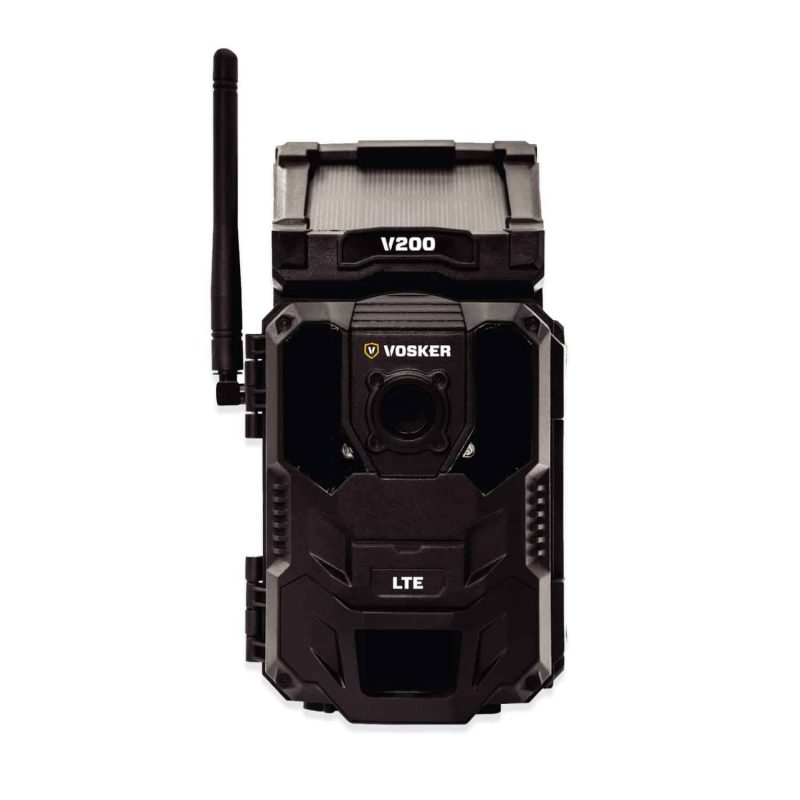
Specs
Connections: 3G | 4G | Ethernet
Carriers: T- Mobile | Verizon | Sprint | AT&T
LCD Screen: Not specified
Resolution: Not specified
Power: Battery | Power cable | Solar panel (built in)
Night Vision: 100 ft
# LEDs: Not specified
Trigger Time: N/A
Motion Detection: Not Specified
Weather Resistant: Yes. No details
Storage: SD Card | Cloud
Voice Control: Alexa
Audio: Not specified
Pros
Built in solar panel
Highly rated
Huge night vision range
Cons
Expensive
Bottom Line
Despite the expense, this is one of my favorite cellular security cameras.
But if you want a high class and reliable piece of kit to monitor a remote but valuable property, look no further.
[5] Spartan 4G Trail Camera

Specs
Connections: 3G | 4G | Ethernet
Carriers: T- Mobile | Verizon | Sprint | AT&T
LCD Screen: 2” color
Photo Resolution: Up to 8MP
Video Resolution: 576P
Power: Battery (x12 AA) | Power cable | Solar panel
Night Vision: 80 ft
# LEDs: Not specified
Trigger Time: 0.6s
Motion Detection: Time Lapse Photos | Clips | Phone Alerts | SMS Alerts | Zones | Sensitivity
Weather Resistant: IP65
Storage: SD Card | Cloud
Voice Control: Alexa
Audio: 1 way
Pros
Highly rated camera
Battery powered with solar panel option
Cons
Limited to a couple of networks
Poor video resolution
Bottom Line
With reasonable photo resolution and lots of motion detection options, this is a trail camera that will work reliably in remote locations.
The price is very reasonable and the only reason that it didn’t make my top four is because of how few people have left feedback about it.
But it is well worth a second look.
[6] Vosker V100 LTE Security Camera
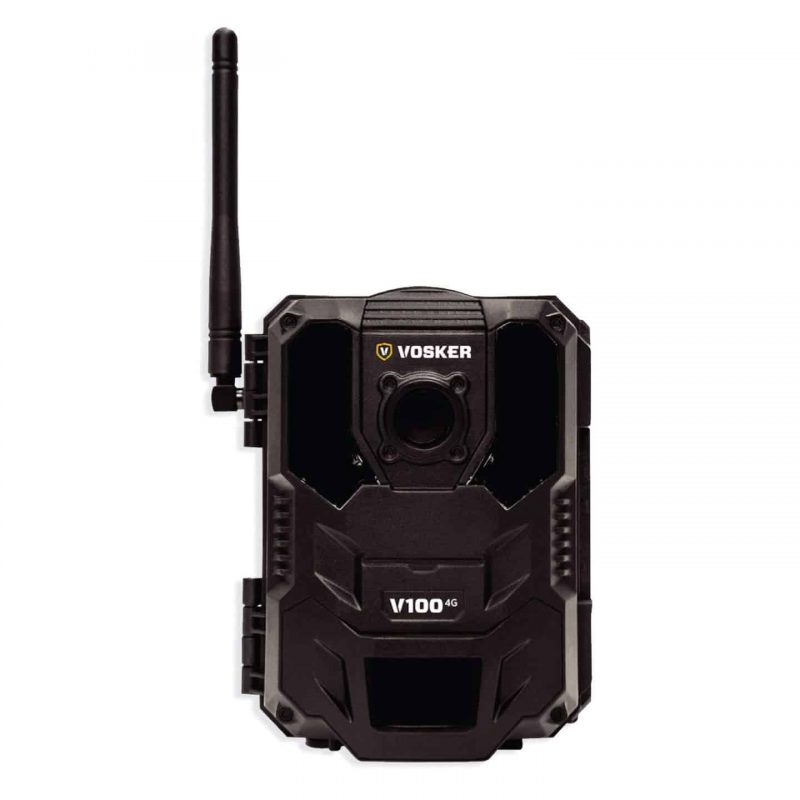
Specs
Connections: 3G | 4G | Ethernet
Carriers: T- Mobile | Verizon | Sprint | AT&T
LCD Screen: Not specified
Photo Resolution: Not specified
Video Resolution: Not specified
Power: x8 AAs | Power cable | Solar panel
Night Vision: 100 ft
# LEDs: Not specified
Trigger Time: N/A
Motion Detection: Not Specified
Weather Resistant: Yes. No details
Storage: SD Card | Cloud
Voice Control: Alexa
Audio: Not specified
Pros
Uses AA batteries
Huge night vision range
Cons
Very few details
Works with only two networks
Bottom Line
The upgraded model is reviewed above. Don’t be tempted by this camera.
[7] Snyper Commander 4G Trail Camera
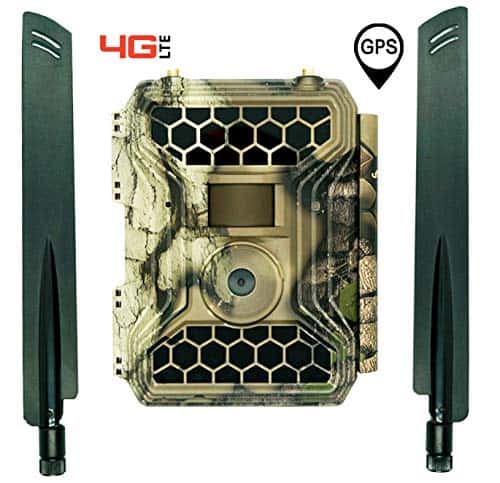
Specs
Connections: 3G | 4G | Ethernet
Carriers: Any Network (SIMHero)
LCD Screen: 2” color
Photo Resolution: 12 MP
Video Resolution: 1080P
Power: Built In Battery | x10 AAs | Power cable | Solar panel (separate)
Night Vision: 75 ft
# LEDs: 56
Trigger Time: 0.4 s
Motion Detection: Intelligent Alerts | Photos | Clips | Phone Alerts | SMS Alerts | Zones | Sensitivity
Weather Resistant: No details
Storage: SD Card (32 GB*) | Cloud
Voice Control: Alexa
Audio: Not specified
Pros
Can be used on any network via SIMHero
Great resolution
Can be charged via solar panel
Cons
Not as highly rated as other security cameras.
Bottom Line
Although there is nothing about this camera to “knock your socks off”, users are generally positive about it, with a few gripes here and there.
[8] Arlo Go Mobile HD Security Camera

Specs
Connections: 3G | 4G
Carriers: Verizon | AT&T | 15 mins $4.99 | 120 mins $22.99
Resolution: Not Specified
Power: Battery | Power cable | Solar panel
Night Vision: 25 ft
Motion Detection: Clips | Phone Alerts | Email Alerts Zones | Sensitivity
Weather Resistant: Yes but not specified
Storage: SD Card | Cloud
Voice Control: Alexa
Audio: 2 way
Pros
Works with Alexa
SD Card and cloud storage
2 Way Audio
Cons
Expensive
Poorly rated
Limited night vision range
Bottom Line
This camera is great for big Arlo fans and for users who want to link their new mobile security camera with Alexa.
But for everyone else, there are better options out there.
[9] SPYPOINT Link-S Solar Cellular Trail Camera
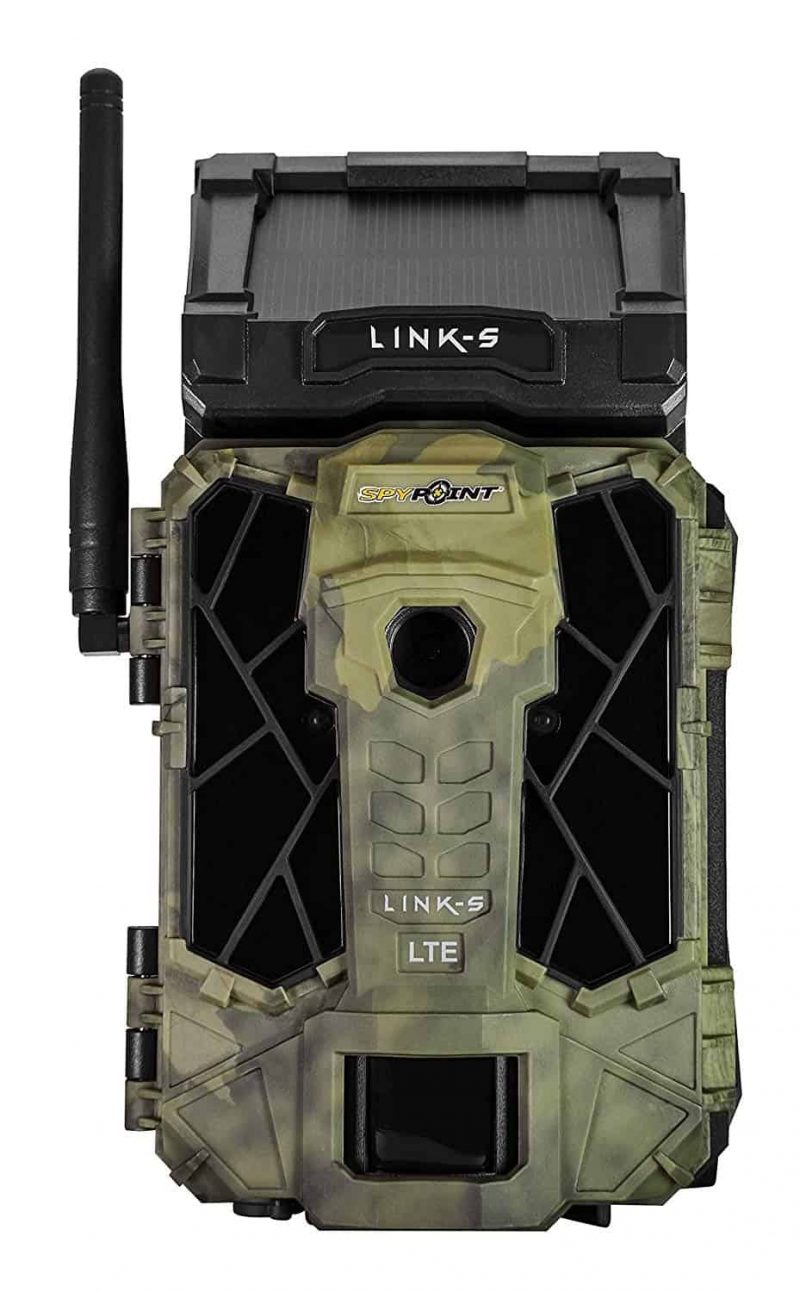
Specs
Connections: 3G | 4G | Ethernet
Carriers: T- Mobile | Verizon | Sprint | AT&T
LCD Screen: 2” color
Photo Resolution: 12MP
Video Resolution: 720p
Power: Rechargeable Battery | x8 AAs | Power cable | Solar panel
Night Vision: 100 ft
# LEDs: 42
Trigger Time: 0.7s
Motion Detection: Photos | Clips | Phone Alerts | SMS Alerts | Zones | Sensitivity
Weather Resistant: Yes. No details
Storage: SD Card | Cloud
Voice Control: Alexa
Audio: 1 way
Pros
Huge night vision range
Built in solar panel
Cons
Above average price
Many users left unimpressed by using it
Bottom Line
There are other trail cameras in my reviews that have the same or better specs and are more highly rated.
[10] Suntekcam 4G LTE Cellular Trail Game Camera

Specs
Connections: 3G | 4G | Ethernet
Carriers: T- Mobile | Verizon | Sprint | AT&T
LCD Screen: Not specified
Photo Resolution: 16 MP
Video Resolution: 1080P
Power: Built In Battery | x8 AAs | Power cable | Solar panel
Night Vision: 100 ft
# LEDs: 42
Trigger Time: 0.3 s
Motion Detection: Photos | Clips | Phone Alerts | SMS Alerts | Zones | Sensitivity
Weather Resistant: IP 66
Storage: SD Card (16 GB) | Cloud
Voice Control: Alexa
Audio: Not specified
Pros
Great night vision range
Good standard of video resolution
Cons
Very poorly rated
Bottom Line
This camera has too few reviews which are critical for you to risk taking a chance on it.
Besides, there are other cameras in my comparison with similar capabilities and much better ratings.
[11] Sanan 4G Sim Card Security Camera
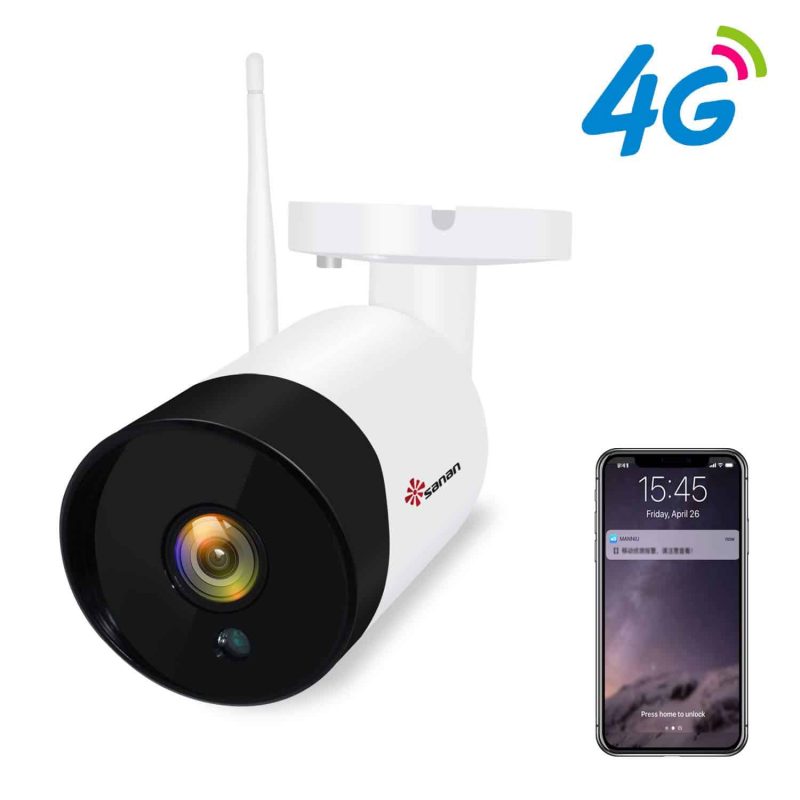
Specs
Connections: 3G | 4G | Ethernet
Carriers: T- Mobile | Verizon | Sprint | AT&T
Photo Resolution: N/A
Video Resolution: 1080p
Power: Battery | Power cable | Solar panel
Night Vision: 66 ft
Motion Detection: Not Specified
Weather Resistant: IP 66
Storage: SD Card (128 GB) | Cloud
Voice Control: Alexa
Audio: Not specified
Pros
Price
Works with lots of networks
Good weather resistance
Large capacity storage
Cons
Very low ratings
Not battery powered
Very few details
Bottom Line
On paper, some of the specs look great. But with very few and very low ratings, don’t be tempted by the price. Move on!
[12] Jimi 3G/ 4G/ WiFi Indoor Surveillance Camera
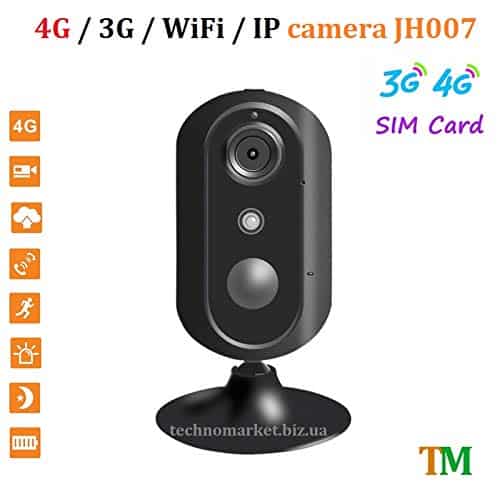
Specs
Connections: 3G | 4G | Ethernet | WiFi
Carriers: Not specified
LCD Screen: No
Photo Resolution: Not specified
Video Resolution: 720p
Power: Built in Battery | Power cable | Solar panel
Night Vision: 30 ft
# LEDs: Not specified
Trigger Time: N/A
Motion Detection: Clips | Phone Alerts | SMS Alerts | Zones | Sensitivity
Weather Resistant: No
Storage: SD Card (64 GB) | Cloud
Voice Control: Alexa
Audio: 2 Way
Bottom Line
Without any kind of feedback, I do not want to distract you with pros and cons.
This camera is not worth the risk and so look elsewhere.
[13] Covert LTE 4G Trail Camera with Freedom Mount

Specs
Connections: 3G | 4G | Ethernet
Carriers: T- Mobile | Verizon | Sprint | AT&T
LCD Screen: 2” color
Photo Resolution: 12 MP
Video Resolution: 1080P
Power: Built In Battery | x12 AAs | Power cable | Solar panel
Night Vision: 100 ft
# LEDs: 60
Trigger Time: 0.7 s
Motion Detection: Photos | Clips | Phone Alerts | SMS Alerts | Zones | Sensitivity
Weather Resistant: No details
Storage: SD Card (64 GB*) | Cloud
Voice Control: Alexa
Audio: Not specified
